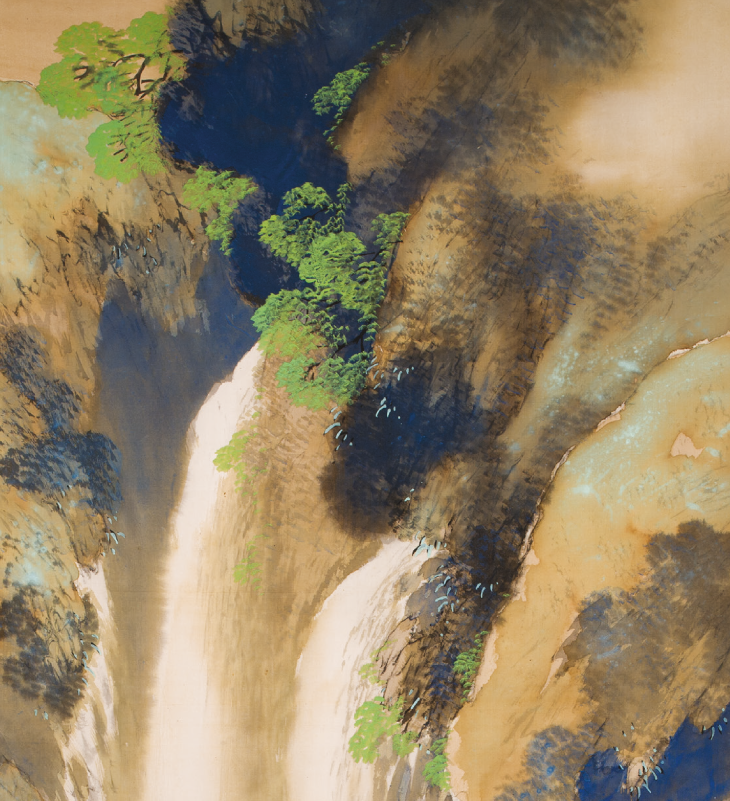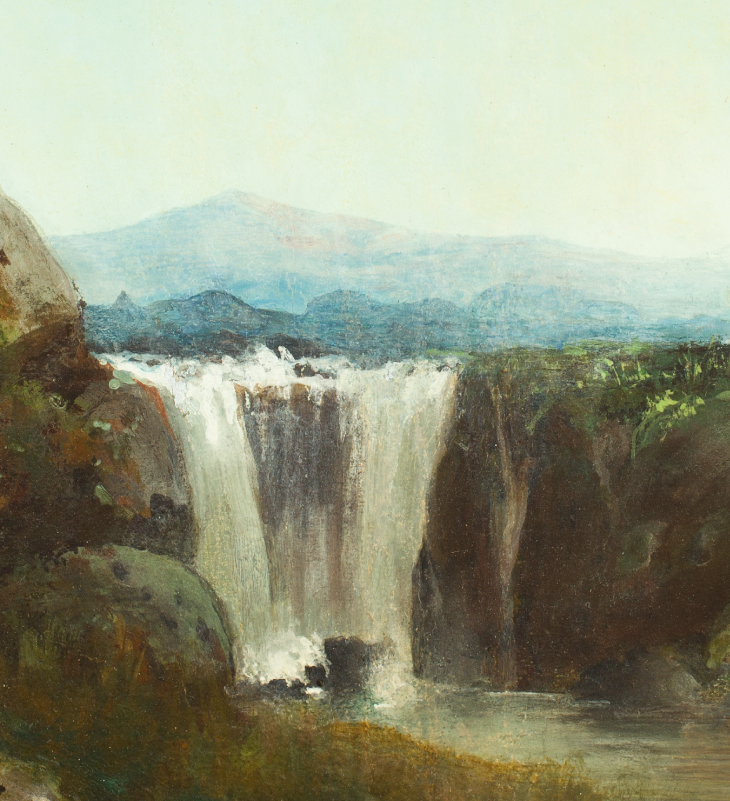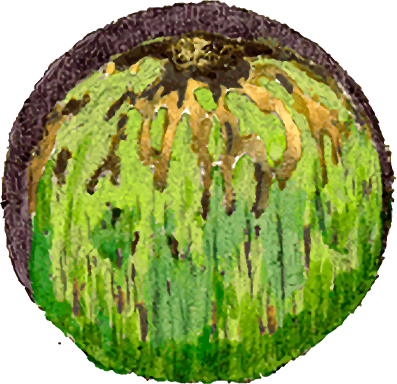
A lo largo de este lapso de tiempo, los procesos de construcción tanto en México como en Japón de una nación
moderna hicieron proliferar nuevos espacios de enseñanza, producción y circulación del arte, y dieron lugar a
una relectura del pasado, de la práctica artística misma, mediante la experimentación de técnicas, formas, medios y mensajes.
Al poeta y crítico José Juan Tablada (1871-1945) debemos el título de la muestra. El escritor recreó en español
la iluminación y la sorpresa del haikú en diversas obras del género, una de ellas la pieza Sauz. Por otro lado,
Tablada fue una figura decisiva en la difusión del arte japonés en México.
El recorrido por la pintura de paisaje mexicana y japonesa propuesta en este diálogo inédito está dividido en cinco ejes temáticos.
El primero de ellos, Gestaciones, aborda el nacimiento del paisaje en México; en contraste, Japón tenía ya una tradición larga
de paisajistas. Le sigue Territorios, un apartado dedicado a mostrar la producción pictórica realizada en diversos lugares:
escuelas nacionales, regionales, tradicionales, así como prácticas independientes.
Throughout this space of time, the construction processes of the modern nation both in Mexico and Japan contributed to the
proliferation of new spaces for education, production and circulation of art and led to a reinterpretation of the past,
of the artistic practice in itself, through the experimentation with techniques, shapes, media and messages.
The title of the exhibition is taken from the poet and critic José Juan Tablada (1871-1945). The writer recreated the
illumination and surprise of the haiku in several works within this same genre, one of them the poem The Willow. Also,
Tablada was a decisive figure when it comes to the promotion of Japanese Art in Mexico.
The tour through the landscape painting of Mexico and Japan put forward in this unprecedented dialogue is divided into
five thematic axes. The first, Emergences, deals with the birth of the landscape in Mexico; Japan, on the other hand,
already relied on a long tradition of landscape painters. Then follows Territories, a section dedicated to showing what
was produced in different places, national and regional schools, and independent practices.
この時代を通じて、メキシコでも日本でも近代国家の建設が進んだ。このプロセスは、芸術教育、芸術制作、作品流通のための新たなスペースを多数生み出し、
技術、形式、メディア、メッセージのさまざまな実験を通して、過去への見方を変え、芸術実践そのものを考え直させた。
展覧会のタイトルは、詩人であり批評家でもあったホセ・フアン・タブラーダ(1871-1945)に由来する。タブラーダは、
俳句による光の当て方とそのもたらす驚きをスペイン語で再現した。その一つが「柳」(Sauz) である。また、タブラーダはメキシコにおける日本美術の普及に決定的な役割を果たした
人物でもある。

La sección Facetas da cuenta del interés de los artistas por formas expresivas distintas.
Exploraciones se centra en las innovaciones formales realizadas por algunos exponentes cuyo
encuentro en sala da cuenta de rupturas surgidas en latitudes tan distantes entre sí. Finalmente,
Ecos ofrece una selección de obra mexicana contemporánea que permite hallar referencias comunes
entre el arte japonés y el nacional. Estos ejes temáticos permiten observar coincidencias y contrastes,
a la par que reconocer en la experiencia estética lo que implicó para México y Japón un periodo en el
arte asociado a la modernidad y a la renovación del lenguaje pictórico.
Casi oro, casi ámbar, casi luz exhibe por primera vez esta notable colección de pintura japonesa al
público mexicano. El Museo Kaluz abre así su recinto al estudio de las relaciones culturales entre Japón y México,
y se presta para incentivar nuevas miradas y posibilidades de interacciones entre el arte mexicano y el japonés.
The section Facets recounts the artists’ interest in different forms of expression: scientific naturalism,
poetry and landscape subjectivity, social criticism, and abstract experimentation. Explorations focuses on the
formal innovations created by some painters whose examples in the exhibition show ruptures that occurred on latitudes
very remote from one another. Lastly, Echoes offers a selection of contemporary Mexican works, which lets us find
common references between Japanese and Mexican art. These thematic axes let us observe coincidences and contrasts,
and the aesthetic experience makes us realize what this artistic period associated with modernity and renovation of
the language of painting meant to Mexico and Japan.
Almost Gold, Almost Amber, Almost Light exhibits for the first time to the Mexican audience Terry Welch’s remarkable
collection of Japanese paintings. The Kaluz Museum thus opens up its premises to the study of the cultural relations
between Japan and Mexico, and it lends itself to encourage new ways of looking at and new possibilities for interaction
between Mexican and Japanese art.
この前例のない対話で提案されるメキシコと日本の風景画の旅は、5つのテーマ軸に分かれている。最初の「胎動」
はメキシコにおける風景画の誕生を扱っている。対照的に、日本には当時すでに風景画家の長い伝統があった。それに続くのは
「地域」で、さまざまな土地での絵画制作に焦点を当てている。全国的な流派や地域的な流派、伝統派や独立した絵画制作などである。次の
「諸相」のセクションは、さまざまな表現形式に対する画家たちの関心に言及している。続く「探索」
では、何人かの表現者による革新的な形式の採用に焦点が当てられる。そして同室に展示されている作品を見れば、互いに非常に離れた場所で、
伝統からの離脱が起きていることが理解できる。最後の「反響」では、日本とメキシコの美術の間に共通するものを表現しようとしているメキシコの現代作品を選んで展示している。これらのテーマ軸を通して、一致と対照が観察され、また、芸術の近代化と絵画言語の刷新をもたらしたこの時期が、メキシコと日本にとってどのような意味を持ったかを、美的体験の中で認識することができる。
「ほとんど金、ほとんど琥珀、ほとんど光」は、この優れた日本絵画コレクションをメキシコで初めて公開している。こうしてカルッツ美術館は、
日本とメキシコの文化関係の研究にその門戸を開放すると共に、メキシコと日本の芸術交流に新たな視点を提供し、その可能性の探究を後押しすることになった。

El saúz
Tierno saúz
casi oro, casi ámbar
casi luz...
